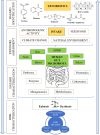Microbiota analysis for risk assessment of xenobiotics: cumulative xenobiotic exposure and impact on human gut microbiota under One Health approach
- PMID: 36531282
- PMCID: PMC9749440
- DOI: 10.2903/j.efsa.2022.e200916
Microbiota analysis for risk assessment of xenobiotics: cumulative xenobiotic exposure and impact on human gut microbiota under One Health approach
Abstract
Human gut microbiota is the microbial community that, through the constant bidirectional communication with its host, plays the critical role of maintaining the state of eubiosis and health balance, contributing to food digestion, detoxification, and proper endocrine, neurological, immunological and potentially reproductive health. To this extent, gut microbiota is called the 'second brain' as well as the 'second liver'. Xenobiotics, including environmental pollutants, are widely spread in the environment and easily accessible in food, cosmetics, personal care products, drugs and medicinal products. Thus, the gut microbiota can be exposed to these xenobiotics, which in turn might alter its composition and metabolism that can trigger dysbiosis, and they seem associated with disorders and diseases in the host. A specific group of xenobiotics, called endocrine-disrupting chemicals, is particularly important due to relevant adverse health effects. A considerable challenge in risk assessment is the combined exposure to xenobiotics, for which the integrated approaches, including the One Health concept, are still under development. Nevertheless, recent research advancements focus on molecular data in the search for elucidating crucial microbiome biomarkers, associated with physiopathology and specific dysfunctions triggered by xenobiotic exposure. In this context, the application of meta-omics and integration of genomics, metagenomics, metabolomics, metatranscriptomics, proteomics and multidisciplinary approaches are particularly important.
Keywords: One Health; combined exposure; environmental omics; farm to fork; microbiota‐disrupting chemicals; unintentional mixtures; xenobiotics.
© 2022 Wiley‐VCH Verlag GmbH & Co. KgaA on behalf of the European Food Safety Authority.
Figures
References
-
- Acharya KD, Parakoyi AER and Tetel MJ, 2022. Chapter 17 – Endocrine Disruption and the Gut Microbiome. In. Editor: Darbre PD. Endocrine Disruption and Human Health (Second Edition). Academic Press, 2022, 355–376. 10.1016/B978-0-12-821985-0.00015-3 - DOI
LinkOut - more resources
Full Text Sources


